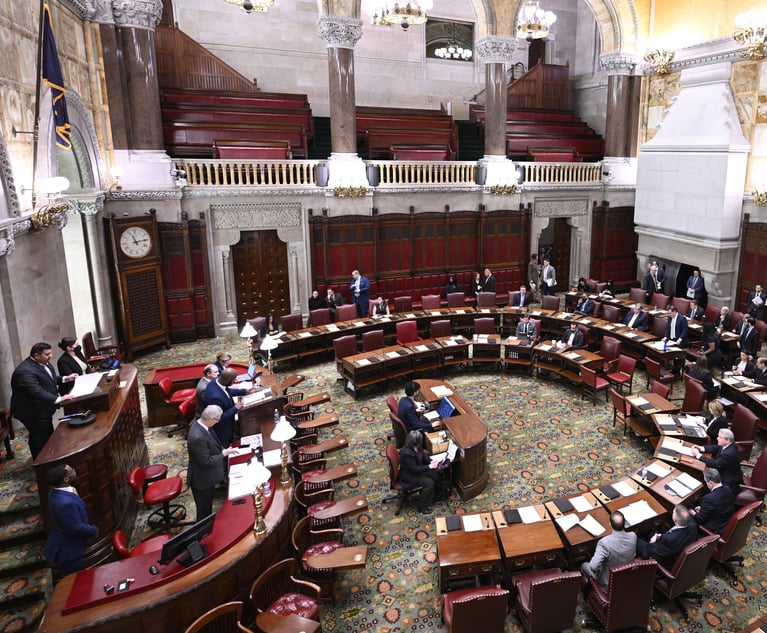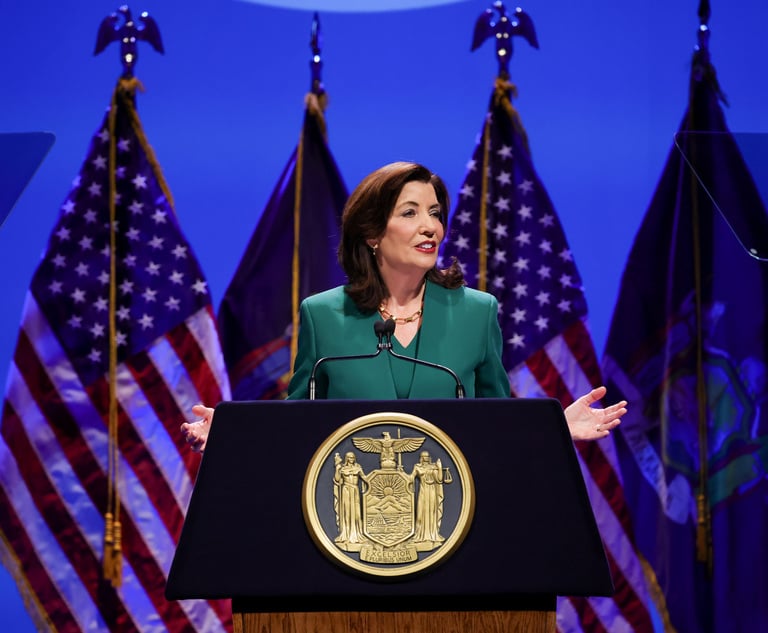New York Courts to Begin Presumptive Mediation for Civil Cases Later This Year
The purpose of the initiative, which will be a significant change to the state's court system, is partly to provide an avenue for litigants to resolve legal matters more efficiently and at a lower cost, Chief Judge Janet DiFiore said.
May 16, 2019 at 03:30 PM
5 minute read
 John Kiernan, head of the Advisory Committee on ADR. (Photo by Rick Kopstein)
John Kiernan, head of the Advisory Committee on ADR. (Photo by Rick Kopstein)
By the end of this year, state courts in New York are set to have a system in place to require that civil litigation be resolved through presumptive mediation, rather than in open court, as part of an effort to continue reducing backlogs in the judiciary.
While such systems already exist throughout some state courts in New York, the new initiative will mandate presumptive mediation and alternative dispute resolution, or ADR, statewide.
The development was expected; Chief Judge Janet DiFiore announced last year that plans were in motion to implement such a program. She also previewed the initiative earlier this year in her State of the Judiciary speech.
The purpose of the initiative, which will be a significant change to the state's court system, is partly to provide an avenue for litigants to resolve legal matters more efficiently and at a lower cost, DiFiore said.
“Making ADR services widely available in civil courts throughout the State—and facilitating the use of such services as early as possible in the case—are major steps toward a more efficient, affordable and meaningful civil justice process,” DiFiore said.
The program will be implemented based on recommendations from the Advisory Committee on ADR, which DiFiore created last year to see the initiative through. The committee is led by John Kiernan, a partner at Debevoise & Plimpton and past president of the New York City Bar Association.
Kiernan said the committee looked at information about practices in every state, as well as the four federal district courts in New York, while compiling its recommendations to DiFiore and the Office of Court Administration earlier this year. They placed special focus on New Jersey, which has had an automatic, presumptive mediation program for more than a decade.
“The overarching impression that you get by talking to the leadership of the judiciary and court administrators in New Jersey … is that, now that the program is basically settled in as a matter of practice, they kind of have a hard time imagining why any court system would not have this procedure in place,” Kiernan said in an interview Thursday.
One striking development in New Jersey, he said, was how strongly attorneys bought into the program after it was implemented. Court officials from the state told Kiernan and the committee that some lawyers who were cautious about the initiative to begin with now favor it over the previous system.
“They commented, for example, that there were categories of practitioners who were initially resistant to mandatory presumptive mediation who now, if you try to take it away from them, would be rioting in the streets because they so strongly buy into this being a better mechanism for resolving disputes,” Kiernan said.
Attorneys practicing matrimonial law have been particularly smitten with the change, Kiernan said. The expectation, based on how it's worked out in New Jersey, is that New York will see similarly positive results.
Deputy Chief Administrative Judges George Silver, Michael Coccoma, and Vito Caruso will be working with the state's administrative and trial court judges over the coming months to expand the number and scope of court-sponsored ADR programs in New York. Those officials will educate attorneys, judges, and litigants on the new system and how it's expected to work.
The Office of Court Administration is also planning to issue uniform rules for the program, including when parties would be able to opt out of presumptive mediation. A framework will be provided for courts to build on while implementing the program.
Not all cases referred to mediation will be disposed of that way; there will still be instances where litigants can't come to a resolution. In those cases, the matter will be dealt with in court rather than through mediation or another alternative method.
It's expected to initially cost the judiciary some money, according to the advisory committee's report. Staff will likely be hired. But the new program is also expected to produce savings in the long run, the report said.
“These recommendations are presented with recognition that they contemplate some reallocation of already tightly stretched judiciary resources toward the proposed expansion,” the report said. “Effective roll-out of broadly expanded mediation programs should ultimately result in reduction of administrative burdens on courts, though, to a degree that the extra expenditures for developing these programs should ultimately pay for themselves.”
The initial cost will also pay for an “important public need,” the report said. Chief Administrative Judge Lawrence Marks echoed that point, saying the new system will help advance the goals of justice for litigants in New York going forward.
“Court-sponsored ADR has a proven record of success, with high settlement rates and strong user satisfaction among litigants and lawyers,” Marks said. “We are eager to move ahead as we bring ADR into the mainstream, offering a far broader range of options to conventional litigation in our ongoing efforts to streamline the case management process and better serve the justice needs of New Yorkers.”
The implementation is expected to take advantage of resources that are already in place, such as volunteer mediators and community dispute resolution centers. The statewide program is expected to begin its rollout in September.
READ MORE:
OCA Names Justice Vito Caruso as New Administrator for Courts Outside NYC
NY AG James, Bar Association President Target Trump in Law Day Remarks
NY Sees Progress on Court Backlog as 'Excellence Initiative' Enters Fourth Year
This content has been archived. It is available through our partners, LexisNexis® and Bloomberg Law.
To view this content, please continue to their sites.
Not a Lexis Subscriber?
Subscribe Now
Not a Bloomberg Law Subscriber?
Subscribe Now
NOT FOR REPRINT
© 2025 ALM Global, LLC, All Rights Reserved. Request academic re-use from www.copyright.com. All other uses, submit a request to [email protected]. For more information visit Asset & Logo Licensing.
You Might Like
View All

Federal Judge Pauses Trump Funding Freeze as Democratic AGs Plan Suit
4 minute read
Relaxing Penalties on Discovery Noncompliance Allows Criminal Cases to Get Decided on Merit
5 minute read
Bipartisan Lawmakers to Hochul Urge Greater Student Loan Forgiveness for Public-Interest Lawyers
Trending Stories
- 1Munger, Gibson Dunn Billed $63 Million to Snap in 2024
- 2January Petitions Press High Court on Guns, Birth Certificate Sex Classifications
- 3'A Waste of Your Time': Practice Tips From Judges in the Oakland Federal Courthouse
- 4Judge Extends Tom Girardi's Time in Prison Medical Facility to Feb. 20
- 5Supreme Court Denies Trump's Request to Pause Pending Environmental Cases
Who Got The Work
J. Brugh Lower of Gibbons has entered an appearance for industrial equipment supplier Devco Corporation in a pending trademark infringement lawsuit. The suit, accusing the defendant of selling knock-off Graco products, was filed Dec. 18 in New Jersey District Court by Rivkin Radler on behalf of Graco Inc. and Graco Minnesota. The case, assigned to U.S. District Judge Zahid N. Quraishi, is 3:24-cv-11294, Graco Inc. et al v. Devco Corporation.
Who Got The Work
Rebecca Maller-Stein and Kent A. Yalowitz of Arnold & Porter Kaye Scholer have entered their appearances for Hanaco Venture Capital and its executives, Lior Prosor and David Frankel, in a pending securities lawsuit. The action, filed on Dec. 24 in New York Southern District Court by Zell, Aron & Co. on behalf of Goldeneye Advisors, accuses the defendants of negligently and fraudulently managing the plaintiff's $1 million investment. The case, assigned to U.S. District Judge Vernon S. Broderick, is 1:24-cv-09918, Goldeneye Advisors, LLC v. Hanaco Venture Capital, Ltd. et al.
Who Got The Work
Attorneys from A&O Shearman has stepped in as defense counsel for Toronto-Dominion Bank and other defendants in a pending securities class action. The suit, filed Dec. 11 in New York Southern District Court by Bleichmar Fonti & Auld, accuses the defendants of concealing the bank's 'pervasive' deficiencies in regards to its compliance with the Bank Secrecy Act and the quality of its anti-money laundering controls. The case, assigned to U.S. District Judge Arun Subramanian, is 1:24-cv-09445, Gonzalez v. The Toronto-Dominion Bank et al.
Who Got The Work
Crown Castle International, a Pennsylvania company providing shared communications infrastructure, has turned to Luke D. Wolf of Gordon Rees Scully Mansukhani to fend off a pending breach-of-contract lawsuit. The court action, filed Nov. 25 in Michigan Eastern District Court by Hooper Hathaway PC on behalf of The Town Residences LLC, accuses Crown Castle of failing to transfer approximately $30,000 in utility payments from T-Mobile in breach of a roof-top lease and assignment agreement. The case, assigned to U.S. District Judge Susan K. Declercq, is 2:24-cv-13131, The Town Residences LLC v. T-Mobile US, Inc. et al.
Who Got The Work
Wilfred P. Coronato and Daniel M. Schwartz of McCarter & English have stepped in as defense counsel to Electrolux Home Products Inc. in a pending product liability lawsuit. The court action, filed Nov. 26 in New York Eastern District Court by Poulos Lopiccolo PC and Nagel Rice LLP on behalf of David Stern, alleges that the defendant's refrigerators’ drawers and shelving repeatedly break and fall apart within months after purchase. The case, assigned to U.S. District Judge Joan M. Azrack, is 2:24-cv-08204, Stern v. Electrolux Home Products, Inc.
Featured Firms
Law Offices of Gary Martin Hays & Associates, P.C.
(470) 294-1674
Law Offices of Mark E. Salomone
(857) 444-6468
Smith & Hassler
(713) 739-1250






